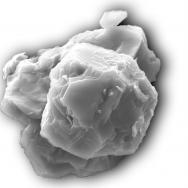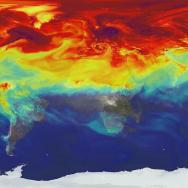The first images from a newly operational telescope reveal unprecedented detail of the sun’s surface and preview the transformative images to come from this 13-foot solar telescope.
The National Science Foundation’s Daniel K. Inouye Solar Telescope, on the summit of Haleakala in Hawai‘i, will enable a new era of solar science and a leap forward in understanding the sun and its impacts on our planet. Activity on the sun, known as space weather, can affect systems on Earth; magnetic eruptions on the sun can impact air travel, disrupt satellite communications and bring down power grids, causing long-lasting blackouts and disabling technologies such as GPS.
“Those of us fascinated by the sun—and who would not be?—have been waiting since the 1980s to see the sun at high resolution, to see if the amazing structuring of its surface, from the grand sunspots down to the ‘salt and pepper’ smaller magnetic field structure, continues to yet smaller spatial scales. And it does!” said Robert Rosner, the William E. Wrather Distinguished Service Professor of Astrophysics at the University of Chicago, who is the co-primary investigator of the project. “And the physics to be mined from this result, these remarkable images, are just so exciting—we can’t wait for more!”
The first images from NSF’s Inouye Solar Telescope show a close-up view of the sun’s surface, which can provide important detail for scientists. The images show a pattern of turbulent “boiling” plasma that covers the entire sun. The cell-like structures—each about the size of Texas—are the signature of violent motions that transport heat from the inside of the sun to its surface. That hot solar plasma rises in the bright centers of “cells,” cools off and then sinks below the surface in dark lanes in a process known as convection.
The telescope, named for late Hawaiian senator David Inouye, began construction in 2010, but has been in planning for decades—in fact, it was famed University of Chicago solar scientist and Prof. Emeritus Eugene Parker, who headed the planning committee back in the 1980s.

“Since NSF began work on this ground-based telescope, we have eagerly awaited the first images,” said France Córdova, NSF director. “NSF’s Inouye Solar Telescope will be able to map the magnetic fields within the sun’s corona, where solar eruptions occur that can impact life on Earth. This telescope will improve our understanding of what drives space weather and ultimately help forecasters better predict solar storms.”
Illuminating what we know about our nearest star
The sun is our nearest star—a gigantic nuclear reactor that burns about 5 million tons of hydrogen fuel every second. It has been doing so for about 5 billion years and will continue for the other 4.5 billion years of its lifetime. All that energy radiates into space in every direction, and the tiny fraction that hits Earth makes life possible.

In the 1950s, Parker suggested that a solar wind blows from the sun to the edges of the solar system—a radical idea that was confirmed by spacecraft. But though this wind envelops the earth, many of the sun’s most vital processes continue to confound scientists.
“On Earth, we can predict if it is going to rain pretty much anywhere in the world very accurately, and space weather just isn’t there yet,” said Matt Mountain, president of the Association of Universities for Research in Astronomy, which manages the Inouye Solar Telescope. “Our predictions lag behind terrestrial weather by 50 years, if not more. What we need is to grasp the underlying physics behind space weather, and this starts at the sun, which is what the Inouye Solar Telescope will study over the next decades.”
Solar magnetic fields constantly get twisted and tangled by the motions of the sun’s plasma. Twisted magnetic fields can lead to solar storms that can negatively affect us; during 2017’s Hurricane Irma, the National Oceanic and Atmospheric Administration reported that a simultaneous space weather event brought down radio communications used by first responders, aviation and maritime channels for eight hours on the day the hurricane made landfall.
Finally resolving these tiny magnetic features is central to what makes the Inouye Solar Telescope unique. It can measure and characterize the sun’s magnetic field in more detail than ever seen before and determine the causes of potentially harmful solar activity.
“It’s all about the magnetic field,” said Thomas Rimmele, director of the Inouye Solar Telescope. “To unravel the sun’s biggest mysteries, we have to not only be able to clearly see these tiny structures from 93 million miles away but very precisely measure their magnetic field strength and direction near the surface and trace the field as it extends out into the million-degree corona, the outer atmosphere of the sun.”

It is expected that notification of potential impacts could occur earlier—as much as 48 hours ahead of time instead of the current standard, which is about 48 minutes. This would allow for more time to secure power grids and critical infrastructure and to put satellites into safe mode.
The engineering
To achieve the proposed science, this telescope required important new approaches to its construction and engineering. Built by NSF’s National Solar Observatory and managed by AURA, the Inouye Solar Telescope combines a 13-foot (4-meter) mirror—the world’s largest for a solar telescope—with unparalleled viewing conditions at the 10,000-foot Haleakala summit.
A specialized cooling system provides crucial heat protection for the telescope and its optics. More than seven miles of piping distribute coolant throughout the observatory, partially chilled by ice created on site during the night.
The dome enclosing the telescope is covered by thin cooling plates that stabilize the temperature around the telescope, helped by shutters within the dome that provide shade and air circulation. The “heat-stop” (a high-tech, liquid-cooled metal donut) blocks most of the sunlight’s energy from the main mirror, allowing scientists to study specific regions of the Sun with unparalleled clarity.
The Inouye Solar Telescope will work with space-based solar observation tools such as NASA’s Parker Solar Probe (currently in orbit around the sun) and the European Space Agency/NASA Solar Orbiter (soon to be launched). The three solar observation initiatives will expand the frontiers of solar research and improve scientists’ ability to predict space weather.
—Adapted from a story that first appeared on the NSF website.








